10 Brewing Mistakes Every Homebrewer Needs To Avoid

Homebrewing can be a complex and time-consuming process, but to create a beautiful batch of beer from scratch is a work of art. The process of brewing beer is pretty straightforward, but it can be tricky even for the most seasoned homebrewers because there are many ways things can go wrong. While it is completely okay to make mistakes, it is always best to learn from others so you can avoid certain blunders that can ruin a good batch of beer. Here is a list of beer brewing mistakes to avoid so you can save time, money, and whole lot of effort.
1. Proper sanitation
The biggest and most common mistake homebrewers make is not maintaining good sanitation. It is important to remember that sanitation and cleaning are two different processes, and you must follow both to ensure that your beer is free of unnecessary elements like dirt or potentially dangerous microorganisms. Most new homebrewers believe that cleaning and sanitizing their brewing equipment can be achieved at the same time in one exercise, but that is not true, as they are two different processes.
Clean equipment will help you create high-quality beer with an amazing flavor, and that is the first rule of homebrewing. The first step is cleaning, and then comes sanitization. By cleaning your equipment, you are removing dirt, grime, and other kinds of build-up from the surface. After this process, you must sanitize the equipment to kill any bacteria or yeast that may have remained from the previous batch of beer brewing or have come in from the air or water. Even a single spot of mold can ruin your precious homebrewed beer. It can alter the fermentation process and leave the brew with an unpleasant finish and flavor. Improper sanitization can make your brew susceptible to adulteration or even unfit for consumption. Everything that comes in contact with your brewing equipment, including yourself, must be thoroughly sanitized before the next batch of beer can be processed. Include a no-rinse brewing sanitizer in your home brewing kit so you can ensure that your equipment is clean as a whistle before you start on your new batch.

2. Always use fresh ingredients
Most new homebrewers start by using brewing kits. It is a great starting point for people who are not completely familiar with the procedure and ingredients that go into making a tasty batch of homebrewed beer. These kits are assembled by brands that have been in the beer brewing game for a while and have researched ingredients and beer styles. Following the instructions on the brewing kit properly will ensure that your final product is delicious and well balanced.
Most experienced brewers agree that the best way to begin your journey of brewing beer at home is using a brewing kit, but they will advise you to focus on the kit’s freshness or best-by date. Even if your kit is from a reputable brand, the ingredients inside may be old or not as viable as you need them to be. The yeast in a brewing kit can slowly degrade over time and become less viable. It is recommended to buy the most recently packed brewing kit you can find so you know that the ingredients are fairly fresh. Also, make sure to follow the directions on the kit so that you do not end up with a flat or foul-smelling brew.
If you are not using a kit and plan on brewing beer from scratch, you should make sure that all the ingredients you procure are as fresh as possible. Beer is made using organic compounds, and these compounds are constantly breaking down unless otherwise preserved. Hops, fruits, spices, herbs, etc. are some ingredients you can use for a fantastic batch of unique tasting beer. These products are also best used fresh, especially herbs and fruits. Using fresh ingredients is the key to superior-quality batch of tasty beer.
3. Pitching the yeast
Yeast is one of the most vital ingredients in the beer brewing industry. There are two kinds that are typically used by brewers – dry and liquid yeast. This special ingredient is what makes wort frothy and gives beer that bubbly texture everyone loves. When you do not use enough yeast, the beer remains underfermented and can taste flat and too sweet. Properly preparing the yeast for a homebrew is known as pitching, and pitching the right amount of yeast can ensure a good fermentation process and result in a healthy batch. Pitching yeast is an important step while homebrewing beer. Underpitching yeast is one of the most common mistakes made by new homebrewers or by those making large batches of beer. Brewing high-gravity beer like Imperial stout or barleywine also requires perfect yeast pitching.
Dry yeast has a much larger cell count compared to liquid yeast, but the yeast cells are in a desiccated form. Rehydrating dried yeast will open up these cells and make them more viable for fermentation. Without rehydrating them, you will be limiting the number of cells significantly. There are yeast calculators or pitch rate calculators you can use to determine the suitable amount of yeast you need to use for a particular batch.

4. Using tap water
The largest constituent in beer is water. That being said, many new homebrewers believe that using regular tap water is good enough to make a good batch of beer since that is what we drink every day. What most people do not realize is that water chemistry plays a vital role in the final product of homebrewing. The water you get from the tap contains chloramine and chlorine, which are added to make the water safe for drinking and other consumption. The presence of chlorine can adversely affect the beer’s chemical composition, creating compounds known as chlorophenols, which give the final product an unappealing flavor that tastes like plastic.
If you plan on using tap water to make your home brew, it is a good idea to leave the water in an open container for a night so that the chlorine, being a volatile compound, evaporates into the atmosphere. You can use campden tablets to remove chloramine from the water so it can be safely used for beer brewing. Tap water also contains a variety of minerals that can alter the taste, pH, gravity, and balance of your beer. Use a water test kit to identify the substances found in your local tap water. There are ways you can remove these substances, or you can fine-tune your brew recipe to include these minerals in the beer for a whole new flavor.
Tap water can also sometimes contain microorganisms that are safe for human consumption, but can alter the fermentation process of your wort. This will, in turn, give you a different end product than expected or a possibly ruined batch. The best way to avoid this is to use boiled tap water for the process. Boiling water kills all microorganisms or spores which can cause unwanted changes to your brew.
5. Setting the right temperature
Brewing beer at home is a lot like baking a cake. It involves fresh ingredients, plenty of mixing, and a suitable amount of time for the final product to be ready. You cannot just pour the cake batter into a baking dish and push it into an oven and expect it to be ready. The oven has to be adjusted to the right temperature and the cake has to be baked for a specific amount of time. The same process applies to the yeast used in your brewing batch.
Storing and activating yeast at the right temperature range is very crucial in brewing a good batch of beer. The yeast package will provide instructions on how to activate the cells and what temperature range you should use. Fermenting the yeast outside the recommended temperature range can result in the formation of fusel alcohols, which can make the beer taste sour and unpleasant. Adding a temperature control to your brewing kit is a great way of maintaining the recommended temperature for your yeast. There are several options or techniques you could use, such as ice, computer fans, or even a freezer with a thermostat or temperature regulator. This will allow you to control the fermentation temperature, which is one of the most common things new homebrewers overlook. If the yeast is too hot or too cold, it affects their ability to ferment the wort. Maintaining a suitable fermentation temperature will give you a batch of great tasting beer in the end.
6. Using wrong measurements
There are a lot of solid ingredients used in brewing beer, and using them in the right amounts is the magic behind an amazing batch of beer. While measuring brewing extracts, homebrewers must remember that not all measuring spoons and cups are made equally. This applies to whether you are measuring gypsum, priming sugar, or any other powdered or solid extracts that you want to add to the batch.
When you are adding ingredients before and after fermentation, it is important to remember that you must always use exact measurements. This is even more crucial while repeating steps. Many powder ingredients can become clumped up or compacted over time and this can make it tricky to get the right measurement. It is recommended to keep these ingredients in air-tight containers in cool and dark storage areas to prevent them from clumping. Avoid exposure to even the slightest amount of moisture. Keep a measuring scale handy to help you weigh ingredients accurately, and this will soon become an invaluable tool in your homebrewing process. Also, remember to always measure dry ingredients by weight and not by volume.

7. Burning or over-boiling the extract
Another common homebrewing mistake is not paying enough attention to your malt extract. While cooking the malt, the extract is heavy and typically settles at the bottom of the kettle. If you do not keep stirring the extract, it will settle and burn at the bottom. If malt burns, it will stick to the bottom of the kettle, and that is a lot of ingredients going to waste. Burned malt extract also changes the flavor of the mixture, giving it a sticky and smoky flavor. While some brewers prefer this flavor, it is not a sign of an efficient brewing process. Remove the kettle from the stove or turn off the heat before you add any extract. Stir the extract into the mixture well so that it is completely dissolved before you turn the heat back on.
Chemical compounds like sugar in the wort can make it sticky, which means that it can boil over if you are not paying close attention. Keep stirring the wort regularly and keep an eye on its temperature so you can avoid a boil-over. A trick some seasoned brewers use to prevent their wort from boiling over is adding glass marbles to their pots. These marbles settle at the bottom and break large bubbles into smaller ones so they do not float to the top and cause the liquid to boil over. Glass marbles are inert and survive high temperatures. They also do not add any flavors to your brew.
8. Using the wrong sized fermenter
Many first-time homebrewers fail to take into consideration what yeast can do. It is a type of microorganism that is essential in fermenting your malt mixture and converting it into beer. When yeast is added to wort and the fermentation has begun, you will notice a significant amount of foam forming at the top. This foam means that the wort mixture is expanding within the fermenter, and a lot of air bubbles are being created as a result. If your fermenter is small and cannot house this expanding wort, some of it will spill out, and you will spend a lot of time cleaning up the sticky mess.
The trick to a hassle-free fermentation is choosing a fermenter that is at least 20 percent larger than your expected batch volume. For example, if you are planning on brewing a five gallon batch, pick a fermenter that is at least six or seven gallons in volume. This extra space allows the yeast to work its magic, and you will not have to worry about an overflow of fermenting wort.
9. Not filtering the wort
Once the wort has been boiled and is ready for fermentation, it contains a large amount of sugars and malty residue. While the sugars are important for your final brew, the malty residue can clog up the wort chiller, which can be a real pain to clean. The malt can also affect the fermentation, hastening or delaying the process, which will eventually alter the final product. It also leaves behind an unpleasant bitter flavor that nobody enjoys in their beer.
To avoid these problems, filter the wort before adding it into the primary fermenter. This will remove excess proteins, starches, and other unwanted compounds from the wort that could change the finish and taste of the final product. This also prevents the yeast from overfeeding after bottling, which could result in some nasty and dangerous explosions.
10. Bottling the beer too soon
This is a common homebrewing mistake seen with impatient brewers. The entire operation of homebrewing involves patiently waiting for long periods of time while different processes have completed so you can move on to the next step. It can sometimes take a long time for the fermentation to take place and successfully convert wort into drinkable beer. As this extends into days, some brewers are tempted to bottle their beer before the process is complete. This means that the beer is still fermenting during bottle conditioning. This causes pressure to build up within the bottles and they can explode, which is both messy and dangerous.
Even though homebrewing can test your patience, it is important to remember that if you follow all the steps and allow all the processes to run their course, the end result is worth it. Follow the recipe and guidelines for your batch and measure everything accurately. You could use a refractometer which will tell you the right time to bottle your beer.

As with all home projects, brewing beer comes with its share of mishaps and mistakes. They are common with people who are just starting, but that should not discourage you. Making mistakes is how you learn, and with brewing beer, you can always start again.
If you have friends who are seasoned homebrewers, use their guidance and expertise to learn how to avoid common rookie mistakes. Ask them how to effectively clean and sanitize your tools, fermenter, kettle, and other parts. They will also tell you which brewing kits are most suitable for beginners. Brewing kits will have clear instructions on the package, so make sure to follow those so you can prevent making simple mistakes. Once you have gotten a hang of homebrewing, you can start experimenting with different flavors and types of beer. Pale ales, witbier, stouts, etc. have different compositions, gravity measurements, finishes, flavors, and techniques. With homebrewing, you can expand your horizon on making tasty beer right at the comfort



